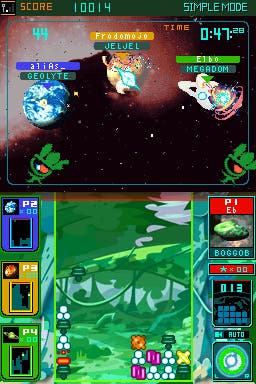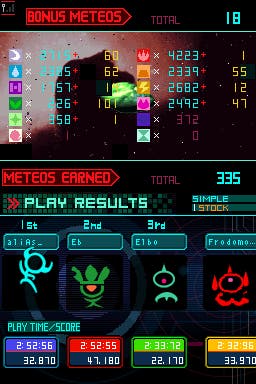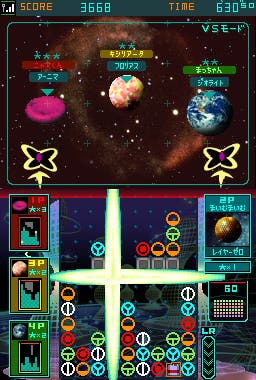Meteos
An absolute blast.
Planets are big things. Interplanetary conflict is even bigger. Meteos, which deals with both, has been put together by Tetsuya Mizuguchi, whose work speaks for itself, and Masahiro Sakurai, who invented Kirby and Smash Bros. From our perspective then, it's a big game about big things. Yet what we find really endearing about it, slightly perversely, is the way it hits so many tiny little nails on the head with such precision.
You've probably realised by now that it's a puzzle game, and we'll do the usual round of explanation in a minute, but it's worth spending a little more time stressing its overarching achievements, because it's probably the most exciting puzzle game we've played all year - and that's on a system that's so far delivered at least a handful of traditional puzzlers, and shoehorned a number of other generic ideas in that direction with varying degrees of success.
Other DS puzzlers like Polarium have demonstrated brilliant core ideas - in that game's case, the way you switch coloured blocks to eliminate them by selecting them in one stylus stroke - but Meteos has several brilliant ideas, and is set up in a manner that gives you a great play options but also continually rewards your endeavours in a very considered way.
It recognises that the core play experience is so strong that tiny, ingenious variations on the winning conditions and mechanics will continue to enthral long past the point at which most puzzlers grow stale, and so it makes these the basis for its unlockables. And it can be played long-form like Tetris by setting up the "Simple" game mode a certain way, played in more comfortable few-minute bursts, played as a concerted campaign - either branching in a manner similar to OutRun's difficulty paths, or with objective-based winning conditions - and even played in a Tetris Attack-style Deluge mode, or against the clock. There's even a wireless multiplayer mode and various power-ups that you can work into proceedings that rain havoc as well as a larger meteor shower on your opponents.
In other words, it's very, very thoughtfully composed. It'd be wrong to suggest it's flawless, but it's designed in a way that commands this weathered critic's respect, and far more importantly is hugely entertaining at that. Certainly a big game then - big in terms of theme, direction, technical achievement and the broadness of its offering.
So let's talk about how it works and why.

The sky weeps
The central idea is that blocks rain from the sky and land in the rectangular play area, and that by linking them into groups of three identical icons you can launch them skyward. You do this by moving blocks up and down the lines they're stacked in using the stylus (or, if you prefer, the d-pad and A button), and while you can't move them side to side you can triumph using horizontal lines of three-or-more as well as vertical ones.
Once they've launched into the air, one of two things will happen. Depending on the weight of the blocks they're launching, the atmospheric conditions of the "planet" you're tackling, or the impact of blocks falling from above, they will either rocket off the top of the screen where they attack your opponent (computer or player-controlled), or they will get to a certain point, run out of momentum and start to tumble back down.
If they start coming back down, you can react in several ways. You can try and fiddle blocks within the airborne cluster into lines of three or more to give them more boost and reinvigorate the ascent; you can make lines lower down the screen to boost them from below (and boosted blocks that overlap even by one square will have the same impact as those coming from directly below); you can flick blocks up from the ground to supplement the airborne pile, allowing you to make chains in mid-air that otherwise wouldn't be possible; or you can let them come back down and then work on them there. If they do land, there's a short window of opportunity to make them part of a larger cluster, which would see them boost back up even if they only slightly overlapped an adjacent block-pile you're boosting. Otherwise they'll settle and you'll have to work at them individually again - something Meteos aficionados refer to as their fusing back to earth.
But then you may not want to take advantage of their lack of fusion, because sometimes the blocks above are blank - yet to assume an icon that indicates which types you'll have to align them with - and sending those blocks off the top of the screen won't achieve anything. You quickly go from randomly sending stuff into the sky to realising that there's a delicate organisation of principles to consider every split-second, and this depth not only inspires you to keep playing but also guarantees that, unlike Polarium, to reuse that example, there's a genuine learning curve and a real sense of getting better at it - something that's central to the success of any out-and-out puzzler.

Hail the comets
What's just as fascinating, as we alluded to earlier, is that there are literally tens of planets, each with different characteristics. The atmosphere is probably very different, meaning that while existing planets may see blocks hurtling up the screen quickly and tumbling down gently, the blocks here go up and down extremely quickly, or waft up and waft down sluggishly - and there are untold depths here too, like the strength in points-scoring and damage-infliction terms of the airborne "combo" boosts. And some of the planet play areas are simply wider.
Rewards take several forms. What you don't realise at first is that every block you send off the screen represents a Meteo that totals up with other Meteos and becomes your currency. There are even coveted blocks that are only yours to seize during the playable end sequence section, which you see on the lower half of the screen as the end credits play out. Imagine the Monkey Ball credit roll-about with a purpose.
With lots of Meteos you can then head into Fusion mode and unlock more planets for use in the Simple, Deluge and Timed modes. You may have encountered them in the Star Trip campaign mode (the one with the branching/objective-based idea), but with a bit of expenditure they become your own to play with whenever you like. You can also spend regular commonplace Meteos on Rare Items that can then, in turn, be invested in more planets. Or sound effects - and while Meteos doesn't link sound to play the same way Q Entertainment's PSP puzzler Lumines does, there's still a cause-and-effect kind of link that has your scrambling to reach an emphatic crescendo move by move. Or you can buy items that become very useful in multiplayer - the sort that prompt a Bomberman-style blow-up-a-couple-of-lines explosion, or hammer their way through blocks.
What you then realise, playing multiplayer in particular, is that while clearing the screen is your goal, having these power-ups fired at you by the other player to clear them is more of an obstacle than a helping hand, because it upsets your stacks and ruins the strategies for boosting tons of blocks off the screen at once that you may be formulating in your head.
There's so much going on - and when there's literally too much happening, with lines starting to flash as they creep off the top of the screen, and the threat of defeat looms, it becomes manic in the way that all good puzzle games manage. Manic in a way that pushes you to think under pressure.
Or to scrub. And unfortunately, this is where we have to start being a bit more critical.

War of the Words about Worlds
The idea of "scrubbing" came to light shortly after the game's Japanese release. It turns out that randomly scrubbing the screen with your stylus in moments of panic may inadvertently link things up and get you out of a tight spot. It's divided opinion of the game, with a lot of people holding off giving it top marks because they see scrubbing as a fundamental flaw.
It is a fundamental flaw. It's also, in our view, nowhere near as significant as has been made out - or even at all, for those of us playing the game as intended. It simply doesn't solve all your problems in the way that's been suggested. It's not a God mode, or an Alt-F4 when you're browsing football news on the Internet and the boss walks round. It can help you, but often it won't, and it's not the way we wanted to play the game, so we simply didn't.
It's going to spark an enormous debate now that Meteos is in the hands of a lot of Western gamers, and this will probably happen again later this year when the game comes out in Europe, but ultimately there's no right answer. It's a shame that it works sometimes, because it upsets an otherwise brilliant concert of intelligent game design. Is it the end of the world? Or at least the planets? We'll let you know what we think in a minute.
First, the other problem - you're going to need a smaller stylus. The tip of the default stylus is okay for playing Meteos, but we've had a great deal more success with something like the Pac-Pix or Mario Kart stylus that we picked up at E3. You may want to consider your options there, or you may find that in moments of sheer mad panic you're let down by your own trembling fingers.
And finally, the multiplayer options. A quick thumbs-up for the one that allows you to transmit a demo version to a friend. Then a bit of a frown for the actual multiplayer mode. It's good, as you'd expect, but it's here, arguably, that scrubbing is going to be most annoying. You may not be doing it, but if you're playing wirelessly with four other people, one of them may. Or you may feel so driven by the fear of losing to the git who lives upstairs and constantly goads you about your gaming skills that you instinctively flail instead of focusing. This is the danger.

Victory!
Scrubbing is a threat to Meteos' brilliance, then, and for that there's a perfectly legitimate argument for taking it down a notch. But we're not going to do that.
We're not going to do that because Meteos wildly succeeds in so many areas and with such comprehensiveness that it deserves your money regardless. There will be those who disagree, but we've explored both sides of it so that's fair enough. Make your own mind up. The simple fact is that whatever your conclusion, everything else Meteos does makes it worth buying. And if you come to it from a position of much experience, as we did, it will capture your heart in a way that leaves you giddy with excitement. When you think about what it's like to play Meteos, you understand why men like Tetsuya Mizuguchi are so revered. Because they thought about it. They thought very hard. And if you respect that the same way we do, and see it borne out the way it is here, you'll play it the best way, and you'll likely agree that it rockets into 9/10 territory with fuel to spare.

